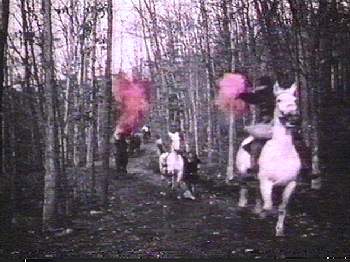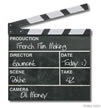The Great Train Robbery, 1903
 GTR was the most commercially successful film of its era and the most popular American
film until 1912.
GTR was the most commercially successful film of its era and the most popular American
film until 1912.
More than a filmed play, GTR combines indoor and outdoor
footage, parallel plot development,
camera movement, and reaffirms the primacy of the shot.
In the GTR, Porter begins to develop a truly cinematographic story telling technique.
However, he is unable to repeat his
success (or maybe just not interested in doing so).
Next: One Reelers
 Read my analysis of Voyage dans la lune and Great Train Robbery (about 7 minute read)
Read my analysis of Voyage dans la lune and Great Train Robbery (about 7 minute read)

Follow this link for the Plot of GTR. It's not really necessary but it might help you remember and analyze the movie.
About that last line, Porter's success: Well, he had many other successful movies and he created many innovations in film. Like Méliès he loved trick photography. One of his most successful films was Dream of a Rarebit Fiend (1906) (Rarebit is a cheese sauce served over bread). You can see it here. You'll see that it's strange and creative, but it ain't no Great Train Robbery. Porter left Edison in 1909 and formed his own company, Defender Films, and promptly failed. In 1912, he joined Adolph Zukor in one of the companies that were eventually to become Paramount. He made a couple films including the 1913 version of Prisoner of Zenda, and worked with some of the big stars of the era. But he left in 1916. After that, Porter left direct involvement in making movies and returned to working only with the machinery. In Movie Made America (1994) Robert Skylar says that "Porter was simply too quiet, modest and unambitious a man. Or perhaps he knew his limitatations better than anyone else." Adolph Zukor said Porter liked to work with machines better than people.
You'll note that Rarebit Fiend is very much a special effects picture. We tend to think of special effects as being modern but they go back to the early days of the movies. Movie makers and audiences were fascinated by the ability of film to alter and distort reality. Many early films were filled with special effects and animations of various kinds. James S. Blackton (1875-1941) was one of the pioneers of this art form. Born in the UK, Blackton came to the US as a child. By the time he was in his late teens, he was working as a reporter and cartoonist for the New York Evening World. He also had a vaudeville stage show with his friend the magician Albert E Smith (1875-1958). The act was a combination of stage magic, projected drawings, and ventriloquism. Blackton was one of the vaudeville talents Edison tapped to make films in the Black Mariah (for example this 1896 film of Blackton sketching Edison). Blackton and Smith were very taken with Edison's ideas and in 1897, bought Edison cameras and projectors, founded The American Vitograph Company and set about making their own films (which led to a protracted legal fight with Edison). By 1900, Blackton was making some short animated films. You can see Blackton again in this very early example, The Enchanted Drawing. By 1906, Blackton was increasingly interested in stop action animation. One of the best examples of his work is the 1906 film Princess Nicotine or the Smoke Fairy. It's a great showcase of early special effects and stop action animation. Notice that the effects that Porter uses in Rarebit and those that Blackton uses in Princess are very different from what Melies used in Voyage. Melies' effects were mostly stage magic. What Blackton does can only be done on film.
So, now you know something more about Porter, Blackton, and animation. I really love writing this stuff...it's kind of a hobby, but I also really appreciate it when students take the time to read what I've written. So, I like to provide a possibility of rewards for people who make it down this far. Here's your reward: if you like, you can watch Dream of a Rarebit Fiend and Princess Nicotine and write a minimum three hundred word review of the two films. Compare them with enough detail that I know that you've done the work and then tell me which is better and why. The maximum for your paper is five hundred words. To submit your paper, make sure it is in msword format, and title it Blackton on the first page. Go to the Canvas site for the course, then assignments, then Canvas Practice and upload it. I'll give you an additional five points of extra credit added to your first exam grade. You must submit your paper before exam one for it to count! Please note that this is an easter egg for students who bother to read down this far in optional material. This only works if you don't tell your classmates about it and don't ask me about it in class (if you do I'll deny any knowledge). It won't show up officially in gradebook but the points will be added to your grade. If you want to talk to me about it, please either come by my office or send me an email. There are numerous other easter eggs scattered in the class. When you want to do an easter egg, just submit the paper to the Canvas Practice (some may say Dropbox, ignore that and use canvas practice). Now, I'm going to add some additional crap to make this look even longer than it is. You may be familiar with what follows. It's called Lorem ipsum after its first words. It's actually a partially garbled passage from the Roman author Cicero but it's commonly used by publishers as dummy text. Lorem ipsum dolor sit amet, consectetur adipiscing elit. Nam pretium id nibh rutrum suscipit. Etiam vulputate ante neque, eu faucibus nisi ornare eget. Phasellus commodo molestie felis, in pharetra eros imperdiet vel. Lorem ipsum dolor sit amet, consectetur adipiscing elit. Aliquam erat volutpat. Sed dapibus semper magna ac efficitur. Curabitur ut dignissim ex, at convallis dui. Nunc egestas volutpat mattis. Morbi eu magna et lorem pellentesque cursus.
Cras semper ligula sit amet faucibus porta. Sed sit amet ligula vestibulum, tempus augue eu, suscipit erat. Vivamus in tellus elementum, facilisis felis at, tincidunt mi. Sed sed lobortis elit. Proin sagittis metus sed lacinia interdum. Suspendisse vitae posuere mi. Praesent ultricies est ac risus cursus pharetra. Vestibulum ante ipsum primis in faucibus orci luctus et ultrices posuere cubilia Curae; Quisque placerat nulla eu nulla venenatis, vel porttitor elit porta. Nam malesuada tincidunt felis, eu condimentum metus dapibus id. Integer condimentum leo eget.
 GTR was the most commercially successful film of its era and the most popular American
film until 1912.
GTR was the most commercially successful film of its era and the most popular American
film until 1912. Read my analysis of Voyage dans la lune and Great Train Robbery
Read my analysis of Voyage dans la lune and Great Train Robbery